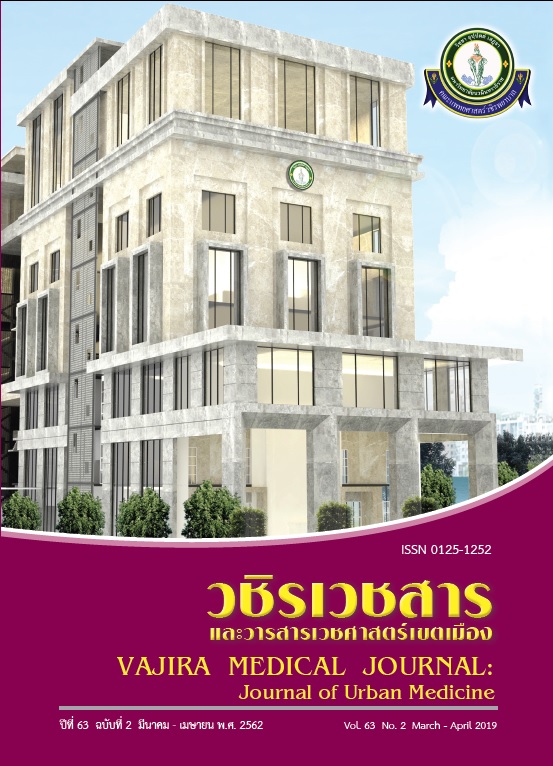Incidence and factors associated with Early Respiratory Distress in Late Preterm Infants
Main Article Content
Abstract
Objectives: To describe the incidence of respiratory distress in late preterm infants born at Vajira hospital. Our secondary objective is to study cause, maternal and neonatal risk factors of respiratory distress in late preterm infants.
Method: A descriptive retrospective study was conducted. Late preterm infants born at 34 – 36+6 weeks gestation between March 1st, 2014 to September 30th, 2017 were recruited in the study. Data including maternal and infant characteristics, cause of respiratory complications and treatment of respiratory distress, were collected from hospital charts.
Results: Three hundred and fifty-five late preterm infants were enrolled. Of these, 47% were male. There were 92, 96 and 167 infants born at gestational age 34, 35 and 36 weeks, respectively. The incidence of respiratory distress was 50.1%. The most common cause of respiratory distress was transient tachypnea of the newborn (TTN) (15.8%), followed by sepsis (14.6%), pneumonia (12.4%) and other causes (12.4%). The incidence of respiratory distress seemed to varied inversely by gestational age. There were 43 (12.1%), 15 (4.2%), 2 (0.6%), 120 (33.8%) infants that needed mechanical ventilator, CPAP/NIPPV, surfactant and oxygen therapy and surfactant, respectively. Factors those were statistically significant associated with early respiratory distress included teenage pregnancy, female infant, cesarean section and birth asphyxia.
Conclusion: In late preterm infants, respiratory problem is very common, thus close monitoring is recommended. Without indication for termination of pregnancy, prolong gestation is warranted in order to decrease chance of respiratory distress. Moreover, late preterm infants, who were born via normal delivery seem to have lower rate of respiratory distress, thus obstetric procedures, including cesarean delivery should be apply only when indicated.
Downloads
Article Details
References
2. Martin JA, Hamilton BE, Sutton PD, Ventura SJ, Mathews TJ, Osterman MJK. Births: final data for 2012.National Vital Statistic Reports 2013;62:9.
3. Kosolchaloenpun S. Comparison of respiratory morbidities between late preterm and term Infants at Siriraj Hospital. Bangkok:Mahidol;2010.
4. McIntire DD, Leveno KJ. Neonatal mortality and morbidity rates in late preterm births compared with births at term. Obstet Gynecol. 2008;111:35-41.
5. Jones JS, Istwan NB, Jacques D, Coleman SK, Stanziano G. Is 34 weeks an acceptable goal for a complicated singleton pregnancy? Manag Care. 2002;11:42-7.
6. Robertson PA, Sniderman SH, Laros RK Jr, Cowan R, Heilbron D, et al. Neonatal morbidity according to gestational age and birth weight from five tertiary care centers in the United States, 1983 through 1986. Am J Obstet Gynecol. 1992;166:1629-41.
7. Arnon S, Dolfin T, Litmanovitz I, Regev R, Bauer S, Fejgin M. Preterm labour at 34–36 weeks of gestation: should it be arrested? Paediatr Perinat Epidemiol. 2001;15:252-6.
8. Pantumapol U. Outcomes of late-preterm infants for 3 years at QSNICH. Bangkok:The Queen Sirikit National Institute of Child Health;2010.
9. Kaladee P, Kositamongkol S. Outcomes of late-preterm infants in Thammasat University Hospital. Thai J Pediatr.2011; 50:42-9.
10. Consortium of safe labor, Hibbard JU, Wikins I, Sun L, Gregory K, Harberman S, et al. Respiratory morbidity in late preterm births. JAMA 2010;304(4):419-25.
11. Bulut C, Gursoy T, Ovali F. Short-term outcomes and mortality of late preterm infants. Balkan Med J. 2016;33(2):198-203.
12. Ganchimeg T, Ota E, Morisaki N, Laopaiboon M, Lumbiganon P, Zhang J, et al. Pregnancy and childbirth outcomes among adolescent mothers: a World Health Organization multicountry study. BJOG. 2014;121(Suppl 1):40-8.
13.Townsel CD, Emmer SF, Campbell WA, Hussain N. Gender differences in respiratory morbidity and mortality of preterm neonates. Front Pediatr. 2017;5:6.


